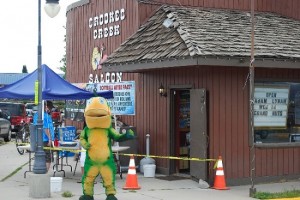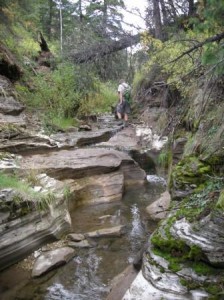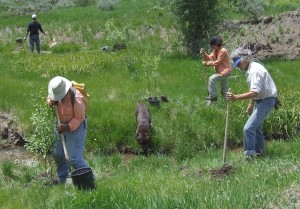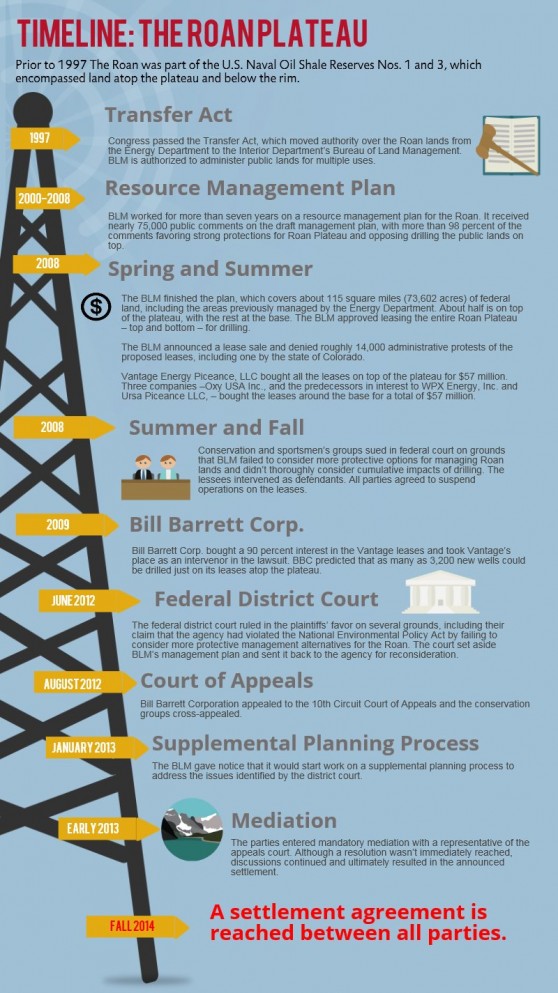- Name: Lori Bertagnoli
- Chapter: Cherry Creek Anglers
- Position: Youth Outreach Coordinator
- Grew up in Michigan, now lives in Colorado with her family
- Owns and operates her own sewing business and is a mechanical engineer
- Best Quote from Lori: “Then he asked me what type of fish it was, and I told him that it was a rainbow trout. He then proceeded to scream at the top of his lungs that he had caught a rainbow trout. This happened with the first fish he caught and every fish he caught afterwards… We created a new fisherman that day and it's something he'll never forget”
Cherry Creek Anglers Youth Outreach Coordinator, Lori Bertagnolli is a beginner at fly fishing herself, but that doesn’t mean she can’t get others passionate about the sport of fly fishing and being in the outdoors.
Growing up in Michigan, Bertagnolli spent her childhood fishing the Great Lakes for Walleye, Perch, Musky and Sunfish. After having her daughters, she moved out to Colorado where they would spend their summers camping and fishing. However, the tactics that worked in Michigan wouldn’t work on Colorado trout. So Lori decided to take up fly fishing.
After taking a fly tying class through Orvis at Park Meadows Mall with help from Colorado Trout Unlimited, Lori received a free yearly membership. From there, she got involved with CTU’s mission and began researching other ways she could help out. Through her research, Lori realized that, “the best tactic is knowledge, and your local TU Chapter is a great place to gain that knowledge.”
 The Cherry Creek Anglers are her local chapter and after attending a few meetings, Lori renewed her membership to a lifetime status, “The Chapter members were friendly and fun, the meetings always had entertaining speakers that expanded my knowledge of fly fishing,” said Bertagnolli. “I was excited to be a part of a group that helped preserve our local waters and promote the joy of fishing.” Within a year she was a member of the Chapter's Board.
The Cherry Creek Anglers are her local chapter and after attending a few meetings, Lori renewed her membership to a lifetime status, “The Chapter members were friendly and fun, the meetings always had entertaining speakers that expanded my knowledge of fly fishing,” said Bertagnolli. “I was excited to be a part of a group that helped preserve our local waters and promote the joy of fishing.” Within a year she was a member of the Chapter's Board.
As a member of the board, she helped the Cherry Creek Anglers put on two youth fishing events at Lake Lehow. In the spring, the Family and Friends Fly Fishing Fun Day (F5 Day), taught kids and families all the basics of fly fishing; and in the fall, Troutastic taught kids how to bait and bobber fish.
At the Troutastic event, the mission was to have every single kid, most of who have never fished before, catch a fish. And they, “achieved that goal and surpassed it by a mile!”
“One of the kids I was helping caught his first fish ever and screamed ‘I caught a fish’ at the top of his lungs, over and over again, from the moment he hooked the fish until we net it and got the hook out,” Lori shared. “Then he asked me what type of fish it was, and I told him that it was a rainbow trout. He then proceeded to scream at the top of his lungs that he had caught a rainbow trout. This happened with the first fish he caught and every fish he caught afterwards… We created a new fisherman that day and it's something he'll never forget” Aside from helping kids master the sport, Lori is still trying to work on her own fly fishing skills and as everyone in the sport knows, that is no easy task. Especially for a mechanical engineer who strives to be very precise and technical. “I'm still learning to cast well and in the mean time I remind myself that in most situations the fish doesn't care if you're a master caster with tight loops, or if you can cast 75 feet. He just wants a beautifully presented fly with a good drift.”
While practicing her cast, Lori likes to switch up the waters that she fishes but remembers to always ‘Match the Hatch’. She takes advice from friends and other members of her chapter for new and beautiful places to fish, with the term “beautiful” as the first priority. “I love to fish places that are picturesque and spending a beautiful day on a beautiful river or lake is more important to me than the number of fish I catch. Being able to relax and enjoy nature is a big part of why I love to fish.”
 Even though in Yellowstone on the Green River, Lori caught the most fish she’s ever caught, that isn't her favorite fishing memory. But instead, it’s a story from Chatfield State Park with her and her 16 year-old daughter, Claire. “We were fishing in our brand-new pontoon boats for the first time. She began to cast close to the cattails and started to hook a bunch of tiny bluegills. Claire hooked a little guy that was so small she didn't even realize it had taken her fly. Thinking she needed to recast, she pulled her rod back and the tiny Bluegill went flying through the air behind her and was flung off her hook into the middle of the pond. We both had the biggest laugh from that. I kept teasing her that, 'fly fishing' wasn't supposed to mean that the fish went flying through the air. Its special days like that, spent with my daughter outside in the fresh air that are the best memories.”
Even though in Yellowstone on the Green River, Lori caught the most fish she’s ever caught, that isn't her favorite fishing memory. But instead, it’s a story from Chatfield State Park with her and her 16 year-old daughter, Claire. “We were fishing in our brand-new pontoon boats for the first time. She began to cast close to the cattails and started to hook a bunch of tiny bluegills. Claire hooked a little guy that was so small she didn't even realize it had taken her fly. Thinking she needed to recast, she pulled her rod back and the tiny Bluegill went flying through the air behind her and was flung off her hook into the middle of the pond. We both had the biggest laugh from that. I kept teasing her that, 'fly fishing' wasn't supposed to mean that the fish went flying through the air. Its special days like that, spent with my daughter outside in the fresh air that are the best memories.”
In her spare time, after working as a mechanical engineer for the automotive industry, Lori began to pursue another hobby of hers, sewing. As her kids got older, Lori opened her own business, Threads of Inspiration, (www.threads-of-inspiration.com). “It is a home-based, custom design embroidery and heat transfer business. I do apparel and gifts for local schools, businesses, and charities. I also create custom gifts for people for special occasions. I embroider the logo-wear for our Cherry Creek Anglers Chapter as well.”
When she isn’t fishing or working on her own business, you can find Lori camping, hiking, traveling, and exploring new places with her family. And even though she won’t consider herself an “awesome angler,” Lori is a perfect example of what fly fishing and CTU is all about.
















